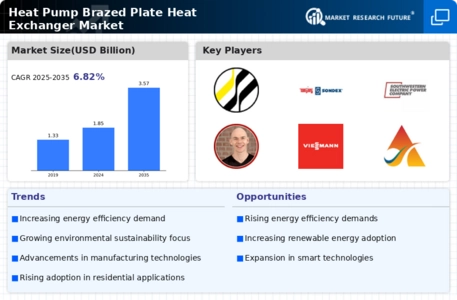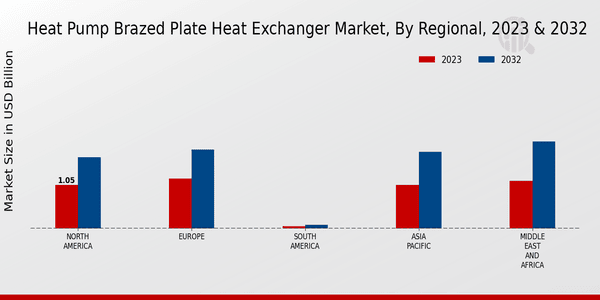Market Growth Projections
The Global Heat Pump Brazed Plate Heat Exchanger Market Industry is projected to experience substantial growth over the next decade. With a forecasted market value of 1.85 USD Billion in 2024, it is anticipated to reach 3.57 USD Billion by 2035. This growth trajectory suggests a robust compound annual growth rate (CAGR) of 6.15% from 2025 to 2035. Such projections indicate a strong demand for heat pump technologies, driven by factors such as energy efficiency, technological advancements, and regulatory support. This upward trend highlights the increasing importance of heat exchangers in various applications across the globe.
Growing Demand for Energy Efficiency
The Global Heat Pump Brazed Plate Heat Exchanger Market Industry is witnessing a surge in demand for energy-efficient solutions. As energy costs continue to rise, consumers and industries are increasingly seeking technologies that reduce energy consumption. Brazed plate heat exchangers, known for their compact design and high thermal efficiency, are becoming a preferred choice. This trend is particularly evident in regions with stringent energy regulations, where the adoption of heat pumps is projected to increase. The market is expected to reach 1.85 USD Billion in 2024, reflecting a growing awareness of energy conservation and sustainability.
Technological Advancements in Heat Exchangers
Technological innovations play a pivotal role in the Global Heat Pump Brazed Plate Heat Exchanger Market Industry. Recent advancements in materials and manufacturing processes have enhanced the performance and reliability of brazed plate heat exchangers. For instance, the introduction of new alloys and improved brazing techniques has resulted in higher pressure resistance and thermal conductivity. These developments not only improve efficiency but also extend the lifespan of the equipment. As a result, manufacturers are likely to invest in research and development, further driving market growth. This trend aligns with the projected CAGR of 6.15% for the period from 2025 to 2035.
Increasing Adoption in Renewable Energy Systems
The integration of heat pump brazed plate heat exchangers in renewable energy systems is a notable driver for the Global Heat Pump Brazed Plate Heat Exchanger Market Industry. With the global shift towards renewable energy sources, such as solar and wind, the need for efficient heat transfer solutions is paramount. Brazed plate heat exchangers facilitate the effective transfer of heat in these systems, enhancing overall energy efficiency. This adoption is expected to contribute significantly to market growth, as more industries and residential applications seek to incorporate sustainable technologies. The market is anticipated to reach 3.57 USD Billion by 2035, reflecting this growing trend.
Regulatory Support for Sustainable Technologies
Government policies and regulations promoting sustainable technologies are influencing the Global Heat Pump Brazed Plate Heat Exchanger Market Industry. Many countries are implementing stringent energy efficiency standards and providing incentives for the adoption of heat pumps and associated technologies. This regulatory support encourages industries to transition towards more sustainable practices, thereby increasing the demand for brazed plate heat exchangers. As governments worldwide prioritize reducing carbon emissions, the market is likely to benefit from favorable policies that promote energy-efficient solutions. This trend is expected to bolster market growth in the coming years.
Rising Urbanization and Infrastructure Development
Urbanization and infrastructure development are key factors driving the Global Heat Pump Brazed Plate Heat Exchanger Market Industry. As urban areas expand, the demand for efficient heating and cooling solutions in residential and commercial buildings increases. Brazed plate heat exchangers are particularly suited for urban environments due to their compact size and high efficiency. The growing construction of energy-efficient buildings and smart homes is likely to further propel the market. With urbanization trends continuing, the demand for heat pump technologies is expected to rise, contributing to the overall growth of the market.






















Leave a Comment